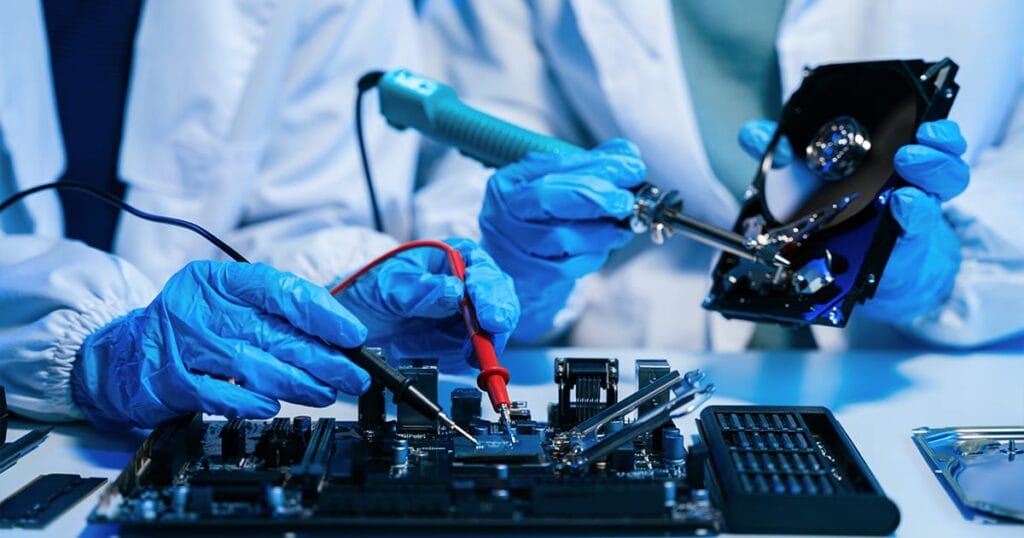
How does gowning work in cleanroom environments?
Introduction to cleanroom environments
Cleanrooms are controlled environments designed to minimize contamination from particulates, ensuring product integrity in critical industries like pharmaceuticals, biotechnology, and electronics. Even minor contamination can compromise product quality and safety.
Cleanroom protocols use strict measures to control contamination, with gowning being a critical aspect. But what is gowning, and how does it work in cleanroom environments? Gowning refers to the process of donning cleanroom attire to prevent contamination from personnel entering the cleanroom. This process is designed to ensure that the cleanroom remains as uncontaminated as possible, safeguarding both products and personnel.
How does gowning work?
Gowning in cleanroom environments is a systematic procedure that involves wearing specific cleanroom clothing designed to minimise the introduction of contaminants. The procedures in cleanrooms are guided by standards such as ISO 14644 for particulate cleanliness and GMP Annex 1 for pharmaceutical manufacturing environments. The process begins before entering the cleanroom, often in a designated gowning area. Staff must follow protocol when gowning, which typically include removing personal items, washing hands, and donning cleanroom attire in a specific order. This order is crucial to ensure that the cleanroom clothing remains uncontaminated during the gowning process.
The attire usually includes coveralls, gloves, masks, goggles, and shoe covers, all made from materials that do not shed particles. The gowning process is not just about wearing cleanroom clothing; it is about doing so in a manner that maintains the integrity of the cleanroom environment.
Why is gowning important?
Gowning is a fundamental component of cleanroom protocol because it serves as the first line of defense against contamination. In industries where precision and sterility are paramount, such as pharmaceuticals and electronics, even a single particle can lead to significant product defects or safety issues. Correct cleanroom gowning protocol are designed to protect the cleanroom from contaminants on clothing or skin. By adhering to these procedures, companies can ensure that products meet the highest standards of quality and safety. Moreover, proper gowning helps protect from exposure to potentially hazardous substances, making it a critical aspect of workplace safety.
Types of cleanroom garments
Cleanroom garments are specifically designed to prevent contamination and are made from materials that do not shed particles. The types of cleanroom attire vary depending on the cleanroom’s classification and the level of protection required. Common cleanroom clothing includes coveralls, which provide full-body coverage, and are often made from non-woven materials that are both breathable and protective. Gloves are essential for protecting both the products and employees, and they are typically made from latex, nitrile, or other non-shedding materials. Masks and goggles protect against airborne particles and provide a barrier against facial contamination. Shoe covers are used to prevent contaminants from being tracked into the cleanroom on footwear.
Each piece of cleanroom attire plays a vital role in maintaining the cleanliness and sterility of the environment. Understanding these garment types lays the foundation for mastering the procedure, which ensures their effective use.
Step-by-step gowning procedure
The gowning procedure is a step-by-step process that must be followed meticulously to ensure the effectiveness of the cleanroom protocol. Here is a typical gowning procedure:
- Enter the gowning area, removing all personal items such as jewelry, watches, and other accessories that could introduce contaminants.
- Wash hands thoroughly with soap and water, and dry them with a lint-free towel.
- Don a hair cover and face mask to prevent hair and facial contaminants.
- Put on a cleanroom coverall, ensuring that it fits snugly and covers all clothing.
- Wear cleanroom gloves, ensuring they cover the cuffs of the coverall.
- Put on goggles to protect against airborne particles.
- Wear shoe covers to prevent contaminants from being tracked into the cleanroom.
- Perform a final check to ensure all cleanroom attire is properly worn and secure.

Following these steps helps maintain the integrity of the cleanroom environment and ensures compliance with protocol.
Common challenges and solutions in gowning
Despite the importance of gowning, several challenges can arise in the process. One common issue is the improper donning of cleanroom attire, which can lead to contamination. To address this, organisations can implement training programmes that emphasise the correct gowning techniques. Another challenge is the discomfort associated with wearing cleanroom clothing for extended periods. To mitigate this, invest in high-quality, breathable materials that enhance comfort without compromising protection.
Additionally, ensuring that cleanroom garments are available in a range of sizes can help accommodate all personnel comfortably. By addressing these challenges, companies can improve compliance with cleanroom protocol and enhance the overall effectiveness of contamination control measures.
The role of training in effective gowning
Training is a crucial component of effective gowning in cleanroom environments. Employees must be thoroughly trained in cleanroom gowning procedures to ensure they understand the importance of each step and how to execute it correctly. Training programmes should include both theoretical and practical components, allowing to practice gowning in a controlled environment. Regular refresher courses can help reinforce proper techniques and address any changes in cleanroom protocol. By investing in comprehensive training, helps to ensure that personnel are equipped with the knowledge and skills necessary to maintain the cleanliness and sterility of the cleanroom environment.
Gowning ensures maximum cleanliness
Gowning is an essential aspect of maintaining cleanliness and sterility in cleanroom environments. By understanding how it works and why it is important, you can implement effective cleanroom gowning procedures that protect both products and personnel. The use of appropriate cleanroom attire, combined with a systematic procedure and comprehensive training, can significantly reduce the risk of contamination.
As industries continue to prioritise quality and safety, the role of gowning in cleanroom environments will remain a critical component of contamination control strategies. Implementing effective gowning protocols supported by proper training and compliance monitoring ensures superior contamination control. Consider partnering with a specialised provider to optimise your cleanroom operations.

Frequently Asked Questions (FAQ)
Gowning serves as a critical barrier to prevent contaminants from entering cleanroom environments. It prevents contaminants entering cleanroom environments from doing so. Personnel can minimize the risk from introducing particles and microorganisms. If such garments are not worn, product integrity and also safety could be compromised. Lindström stresses the need for gowning properly in order to maintain the sterility and the cleanliness that industries such as pharmaceuticals and biotechnology do require.
The gowning process involves a systematic procedure where personnel don specific cleanroom attire in a designated order. This includes the removal of personal items and the washing of hands plus garments such as coveralls, gloves, masks, goggles, and shoe covers are put on. The sequence is designed so that cleanroom clothing is uncontaminated during the overall process. It also acts for the safeguard of the controlled environment.
Donning cleanroom garments in proper sequence is important indeed. This prevents contamination upon the attire itself. Each garment that is remaining uncontaminated and is functioning effectively as a barrier follows the correct order. Lindström highlights that we must adhere by this sequence. Doing of that is important for keeping the cleanroom environment’s integrity.
Challenges in cleanroom gowning include ensuring protocols, maintaining garment integrity, and preventing human error during gowning. Lindström addresses these challenges by way of high-quality garments made for contamination control along with thorough training programs meant for ease of use in addition to effectiveness.
Lindström backs cleanroom gowning since it supplies special clothes meeting industry rules, it gives courses for correct gowning methods, and it makes certain clothes get upkeep via proven washing ways. Organizations are helped via their thorough approach. It maintains a cleanroom’s safe and clean environments.



